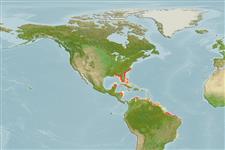Common names from other countries
Environment: milieu / climate zone / depth range / distribution range
Ecologie
Demersaal; zoetwater; brakwater; diepteverspreiding 0 - 13 m (Ref. 116169), usually 2 - 5 m (Ref. 81178). Tropical; 38°N - 21°S, 89°W - 35°W
Western Atlantic: Trichechus manatus manatus: from the coasts and rivers of Mexico to as far south to Rio Doce, Brazil including the Orinoco and Amazon; Trichechus manatus latirostris: from the Florida Peninsula to Rhode Island. Tropical to temperate.
Length at first maturity / Size / Gewicht / Leeftijd
Maturity: Lm ? range ? - ? cm Max length : 390 cm TL mannelijk/geslacht niet bekend; (Ref. 1394); Maximaal gepubliceerd gewicht: 1.6 t (Ref. 1394)
Found in coastal marine, brackish and freshwater areas. Feeds on aquatic plants, (i.e. water hyacinths and marine seagrasses, algae, parts of mangrove trees, floating and shoreline vegetation); invertebrates (i.e. tunicates); and fish they remove from fishing nets (Ref. 1394). Found in coastal marine, brackish and freshwater areas (Ref. 1394), where primary habitat consists of rivers, coastal lagoons and bays and mangrove islands (Ref. 86755). Feeds on aquatic plants, (i.e. water hyacinths and marine seagrasses, algae, parts of mangrove trees, floating and shoreline vegetation); invertebrates (i.e. tunicates); and fish they remove from fishing nets (Ref. 1394).
Jefferson, T.A., S. Leatherwood and M.A. Webber. 1993. (Ref. 1394)
Status op de Rode Lijst van het IUCN (Ref. 130435)
Status bij CITES (Ref. 108899)
Gebruik door de mens
Visserij: commercieel
FAO - Visserij: soortsprofiel | FishSource | Sea Around Us
Tools
Meer informatie
Leeftijd/Grootte
Groei
Lengte-gewicht parameters
Lengte-lengte parameters
Morfologie
Larven
Abundantie
Internet-bronnen
Estimates based on models
Preferred temperature
(Ref.
115969): 22.9 - 28, mean 26.5 (based on 562 cells).
Kwetsbaarheid
Very high vulnerability (90 of 100).
Prijsklasse
Unknown.
